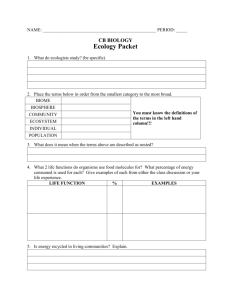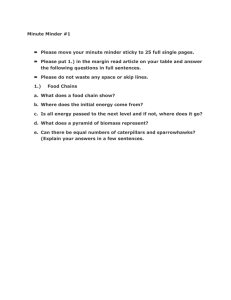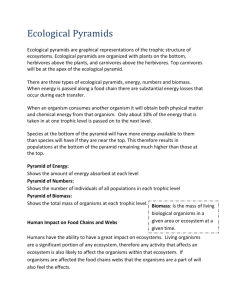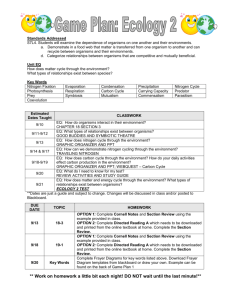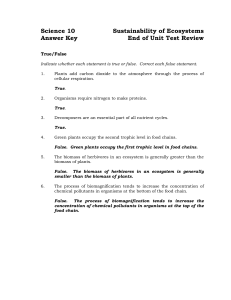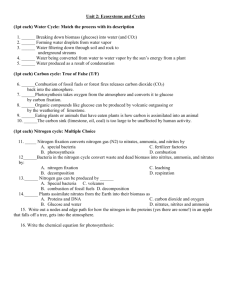Unit 3 topic 2 Energy flow in Ecosystems
advertisement
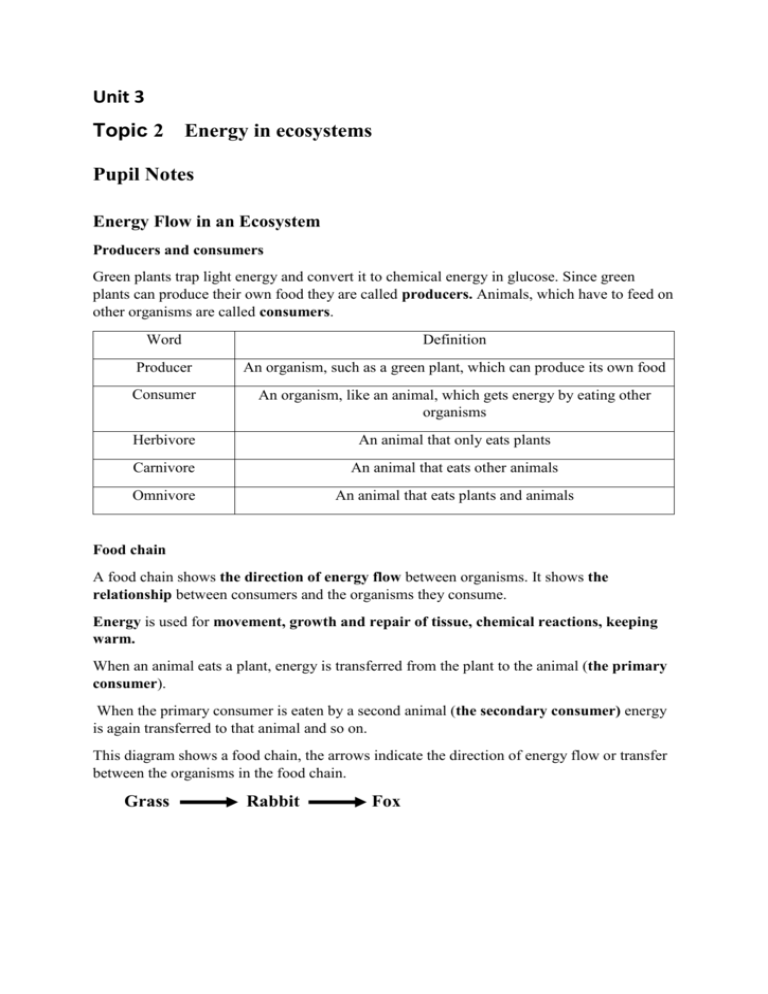
Unit 3 Topic 2 Energy in ecosystems Pupil Notes Energy Flow in an Ecosystem Producers and consumers Green plants trap light energy and convert it to chemical energy in glucose. Since green plants can produce their own food they are called producers. Animals, which have to feed on other organisms are called consumers. Word Definition Producer An organism, such as a green plant, which can produce its own food Consumer An organism, like an animal, which gets energy by eating other organisms Herbivore An animal that only eats plants Carnivore An animal that eats other animals Omnivore An animal that eats plants and animals Food chain A food chain shows the direction of energy flow between organisms. It shows the relationship between consumers and the organisms they consume. Energy is used for movement, growth and repair of tissue, chemical reactions, keeping warm. When an animal eats a plant, energy is transferred from the plant to the animal (the primary consumer). When the primary consumer is eaten by a second animal (the secondary consumer) energy is again transferred to that animal and so on. This diagram shows a food chain, the arrows indicate the direction of energy flow or transfer between the organisms in the food chain. Grass Rabbit Fox Food webs An ecosystem contains many interconnecting food chains. A food web is a diagram that shows these interconnected food chains. An example of a food web is shown below Fox Skylark beetle Grouse Moth Producers Primary consumers Secondary consumers Heather Grouse Grouse Moss Beetle Fox Moth Skylark Moss Heather All food webs are delicately balanced. A change in the number of one type of organism can have an effect on the number of every other plant or animal in the food web. When the number of a particular organism in a food web is reduced: The numbers of its predators may decrease because their food source has decreased The numbers of its prey may increase because they have fewer predators feeding on them The numbers of its competitors (animals eating the same food) may increase because there is now more food available to them The numbers of animals having the same predators may decrease because the predators eat more of them. Transfer of energy The transfer of energy from one level of a food chain to the next is not efficient, only about 10% is transferred to the next level, 90% is lost, e.g. Grass Rabbit Fox When the rabbit eats the grass some of the energy in the grass will be lost as undigested materials in its faeces. The rabbit uses the energy in the grass for RESPIRATION which allows it to heat its body and move. Once this energy is used up it is no longer available to the fox in the next stage At each level in a food chain 90% of the energy is lost as • Heat • Movement • Undigested materials Grouse Pyramids of Numbers / Biomass / Energy These pyramids are diagrams displaying the change in numbers, biomass or energy at different levels along a food chain. 1. Pyramids of Numbers Indicates the numbers of organisms at each level There are three types of pyramid:- Secondary consumers Primary consumers Decreasing numbers Producers This ‘pyramid shape’ is very common when counting numbers as it is usual for there to be a larger number of smaller living things ( e.g. Rabbits ) providing the food for smaller numbers of larger living things ( e.g. Foxes ) This pyramid shape is not the only shape possible b) Inverted (upside down ) pyramid, e.g. when the food chain involves parasites parasites aphids Producer, e.g. rose bush c) Irregular shape e.g. Food chain based on large tree Secondary consumers, e.g. birds Primary consumers, e.g. insects Producer, e.g. tree Biomass The biomass of a population is the total mass of the living things at that stage. This is much harder to measure than counting numbers but gives a much better measure of the loss of energy in a food chain 2. Pyramids of Biomass A pyramid of biomass shows that the biomass of organisms decreases at each level of the food chain: Biomass of secondary consumers Biomass of primary consumers Biomass of producers Pyramids of biomass are usually pyramid shaped because each level gets all of its biomass from the level below, so the lower level cannot have a smaller biomass. 3. Pyramids of Energy The total available energy at each level of a food chain is always pyramid shaped. Since there is loss of energy at each stage, higher levels always have less available energy than lower levels. Decreasing energy at each level Available energy from secondary consumers Available energy from primary consumers Available energy from producers Competition in Ecosystems In ecosystems, competition occurs when two or more members of a community need the same resource. The size of any population is limited by one or more of the following factors Plants compete for:• Light • Water • Soil nutrients • Space etc. Animals compete for:• Food • Water • Shelter • Territory • Mate There are 2 types of competition:Interspecific – between different species Intraspecific – between members of the same species The more the niches of two living things overlap the greater the competition for resources. Different species may reduce competition by: Selecting different prey Feeding at different times Nesting in different habitats Two species with exactly the same niche will result in the migration or extinction of one species. This is called the competitive exclusion principle. An example of two species with almost exactly the same niche are the grey and red squirrels. The grey squirrel is larger, uses wider variety of foods and is more aggressive. This means that in areas with grey squirrels the red squirrel population is pushed out or dies away. Another example of two species with very large overlaps in niche are the rainbow and brown trout. Rainbow trout ousts brown trout. Rainbow trout are more aggressive and greedy for food Members of the same species have ways of reducing competition and ensuring that the best adapted survive to pass on their genes to the next generation. For example in birds such as robins and red grouse, males set up territories from which other males are excluded so that only the male owning the territory is allowed to hunt for food in it. The territory is usually defended by behavioural displays rather than fighting so energy is conserved and injury avoided. Nitrogen Cycle Nitrogen is needed by plants to make protein. Plants usually get their nitrogen by absorbing nitrates through their roots. Animals get protein by eating plants or other animals that have eaten plants. Nitrogen compounds (like proteins) in the dead bodies of plants and animals and in animal wastes are broken down by decomposers such as bacteria and fungi to produce ammonium compounds Nitrifying bacteria change the ammonium compounds into nitrites then into nitrates. Nitrogen fixing bacteria convert nitrogen gas in the air into nitrate. Some of these bacteria are found in the soil, other types live inside swellings called root nodules in the roots of a type of plant called legumes. Examples of legumes are beans and clover. Denitrifying bacteria in waterlogged soil change soil nitrate into nitrogen gas Stage in nitrogen cycle Nitrogen fixation Denitrification Decomposition Nitrification Organisms involved Nitrogen fixing bacteria Denitrifying bacteria Decomposers, e.g. bacteria and fungi Nitrifying bacteria Reactions Nitrogen nitrate Nitrate nitrogen Protein ammoniu Ammonium Nitrite Fertilisers Fertilisers are added to the soil to supply nitrates and increase crop yields Nitrite Nitrate



